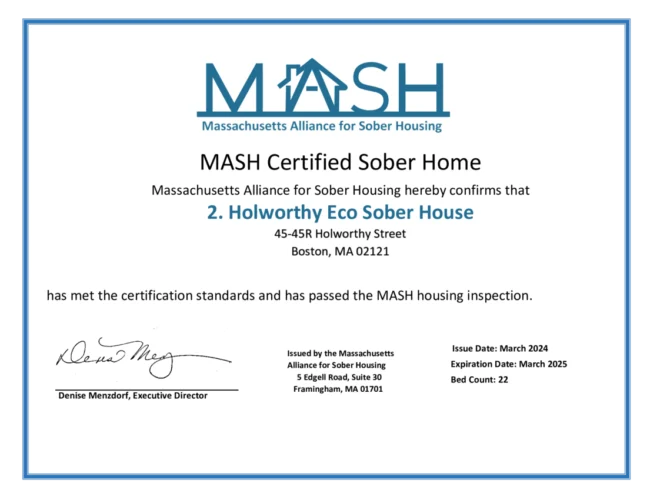
Stays in halfway houses are often court-mandated, so one should expect a regimented schedule that encourages residents to seek employment and get back on their feet. You can expect staff to be on-site and to enforce house rules, such as curfews and regular drug testing. These steps help maintain a drug-free and more structured environment to keep yourself accountable once you move on. Some halfway houses are specific for individuals with mental health issues or those who have recently been released from prison. The focus of the facility may vary depending on the needs of the population being served.
What is the Professional Term for Halfway House?

We publish material that is researched, cited, edited and reviewed by licensed medical professionals. The information we provide is not intended to be a substitute for professional medical advice, diagnosis or treatment. It should not be used in place of the advice of your physician or other qualified healthcare providers. You’ve gone through medical detox and completed https://ecosoberhouse.com/ an inpatient or outpatient treatment program. While going home may seem like a relief after so much time in treatment, for some people, the thought is overwhelming—especially if you’re in a triggering environment or don’t have a strong support system at home. Most halfway houses require that residents abstain from drug or alcohol use while living in such facilities.
Maintaining Sobriety:

Community meals are shared, especially at lunch and evening meals, so the residents bond and socialize with each other. Housekeeping duties and commitments are usually delegated to occupants as a part of their everyday tasks, developing accountability and aiding in the upkeep of the housing. Our application can be used as a driving calculator to determine the distance between two locations, travel time, what’s halfway between, as well as a road trip planner. It’s not just about finding the exact halfway point, many times we also want to find somewhere great to go. For that reason, MeetWays includes reviews to help you find the perfect spot for meeting up. However, in a sober home, you work with a professional who helps to keep you focused and provides ongoing relapse prevention education.
How RRCs Operate and When to Impose
Halfway houses have been shown to reduce outside triggers that can lead to relapse and to provide peer support. Furthermore, structured halfway houses have been shown to teach residents accountability for their actions and choices, ultimately and whats a halfway house effectively leading to a maintained sober life. Although most halfway houses have a similar structure, each facility has different requirements and expectations of its residents, so it’s best to ask the facility you’re interested in about rules.
- Instead, courts have the authority to provide transitional housing under the Second Chance Act of 2007, codified at 18 U.S.C. § 3672 and modified by the Judicial Administration and Technical Amendments Act of 2008 (JATAA).
- Contact us today for more information about this critical step toward sustained recovery.
- The living conditions and the number of residents vary in every facility.
- But knowing what they are allows you to avoid them or develop coping strategies.
- Informed by her personal journey to recovery and support of loved ones in sobriety, Jessica’s empathetic and authentic approach resonates deeply with the Addiction Help community.
Halfway House Rules and Guidelines
However, leaving the halfway house without permission, during curfew hours, or otherwise violating the rules of leaving the home can lead to consequences such as eviction from the program. Sober living arrangements are designed for those who need more support in their recovery than is available at their own homes. Those who are actively in recovery as well as those who have completed a rehabilitation program and are nearing readiness to re-enter the community stay at halfway houses.
- The day usually starts with a group activity, such as breakfast, and sometimes a meeting or a meditation session to set positive intentions.
- The key purposes of halfway houses are to help people remain sober, develop the required living skills, find stable accommodation and jobs, and ultimately get back into society as productive members.
- It is important to note that each halfway house will have its own set of regulations that visitors must abide by.
- Community meals are shared, especially at lunch and evening meals, so the residents bond and socialize with each other.
- Additionally, there are sober living options for young adults that cater to the unique needs of younger individuals seeking recovery.
These are typically located in single-family homes in stable communities whose residents hold each other accountable and promise to not use drugs or alcohol. A monitored location is one step up and has a house manager present who sets rules and procedures and holds individuals accountable. These can be slightly larger and are sometimes in apartment complexes. A recovery residence (sober living home) provides a safe space with an ingrained social support system for post-detox patients following inpatient treatment but during outpatient treatment. This means that you’ve already completed detoxing from whatever your addiction was and are now in the early stages of sobriety.
I’m In Recovery

State-licensed halfway houses can be referred to by a variety of terms, like Transitional Centers, Reentry Centers, Community Recovery Centers, etc. These facilities work with corrections departments to house individuals leaving incarceration, often as a condition of parole or other post-release supervision or housing plan. A halfway house is a good option if returning to normal life is too overwhelming, but you no longer need medical supervision. It allows you to live in a safe, substance-free environment while readjusting to life outside treatment.
- Those who lack a stable, drug-free and alcohol-free living environment are at high risk of relapsing.
- They are used as an alternative to pretrial detention, for alternative (non-custodial) sentences, as a prerelease option from incarceration, and as an intermediate sanction for noncompliance by persons under supervision.
- The slow reintegration into society including a routine schedule and accountability may help create a solid foundation to rebuild a sober life.
- Most often, a sober home will help you by providing on-site or nearby 12-step programs.
These facilities offer a variety of services, including those aimed at promoting mental health stability and at the development of life skills. Such services help ensure successful reintegration into the community, particularly for individuals who are transitioning to independent living from intensive mental health care settings, such as psychiatric hospitals. A halfway house is a transitional living facility for individuals in the early stages of recovery from substance abuse. It offers a safe and supportive place where they can continue their recovery from addiction to drugs or alcohol after leaving inpatient treatment programs, federal prison, or the streets as a homeless person. In some cases, the court mandates an individual to stay in a halfway house.

Halfway Houses Provide Discipline Accountability and Supervision (Critical For Discipline)
The saying “you can’t heal in the same environment that made you sick,” is poignant, especially for those who have checked into drug rehab. American Addiction Centers (AAC) is committed to delivering original, truthful, accurate, unbiased, and medically current information. We strive to create content that is clear, concise, and easy to understand.
